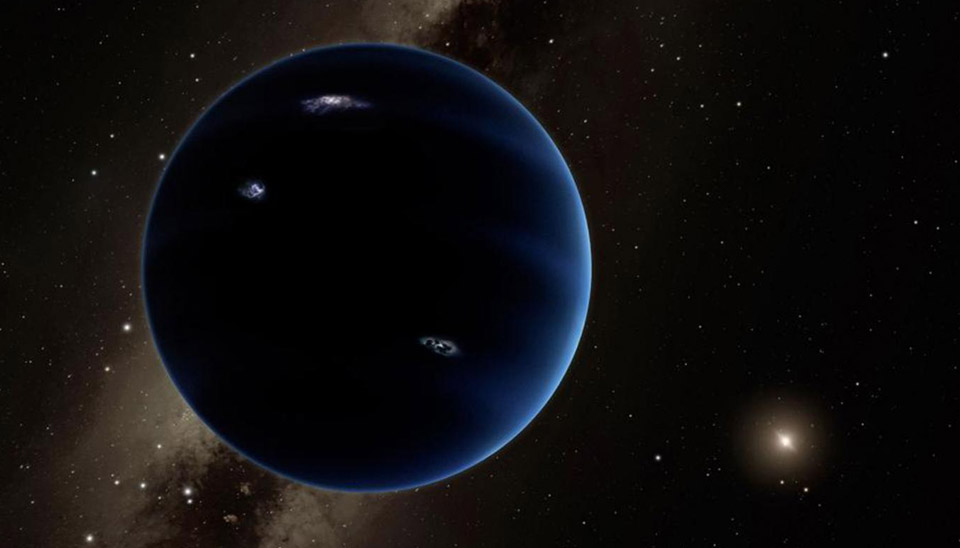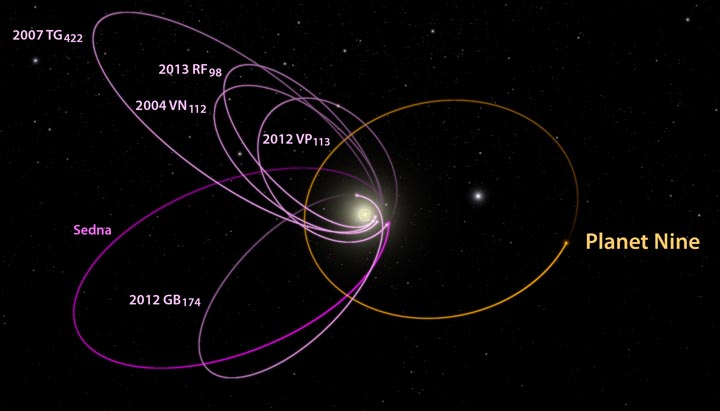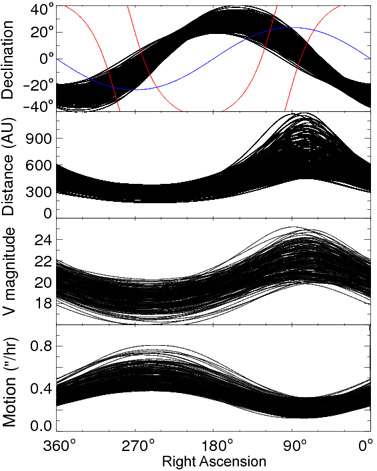Making the Case for “Planet Nine”
Does a massive, extremely distant planet orbit the Sun? A new analysis of distant solar-system orbits argues that it should exist.
It's been almost a century since self-made astronomer Percival Lowell died. He famously predicted the existence of a "Planet X" beyond Neptune, which led to a search effort at Lowell Observatory, which in turn led to the hiring of Clyde Tombaugh, which . . . well, you know the rest of the story.

The hypothesized "Planet Nine" would average about 100 billion km away and take 10,000 to 20,000 years to orbit the Sun.
Caltech / Robert Hurt
Caltech / Robert Hurt
Now a new, prediction-driven search for a massive, distant planet is under way, spurred by orbital quirks among some of the solar system's most distant objects. That search will be accelerated thanks to a new analysis that provides circumstantial evidence for a seriously big, yet-to-be-discovered planet very far from the Sun.
Writing in February's Astronomical Journal, Konstantin Batygin and Michael Brown (Caltech) describe how Kuiper Belt objects that average at least 150 a.u. from the Sun and never come closer than about 50 a.u. share an interesting dynamical property. They have perihelia, the point of their orbits closest to the Sun, that all cluster near the ecliptic plane — and they're all moving south to north when they pass through perihelion. (For the future interplanetary navigators among you, this orbital parameter is termed argument of perihelion.)
It's more than just a quirk coincidence, and this clustering started to get lots of attention after the discovery of the object 2012 VP113 a few years ago. In announcing that find, Chadwick Trujillo (Gemini Observatory) and Scott Sheppard (Carnegie Institution for Science) noted the perihelic similarity of 2012 VP113, 90377 Sedna, and 10 other bodies. Moreover, these objects orbit in a kind of dynamical "no man's land" that defies easy explanations for how they got there. They conclude that a massive planet, even farther out, could have been responsible. I wrote a long blog about all of this in 2014.

Orbits for the six most distant known objects in the solar system, whose orbits (shown in magenta) remain beyond Neptune), all align in one direction. A hypothesized massive "Planet Nine" (orange orbit) could be responsible for their perplexing alignment.
Caltech / Robert Hurt
Caltech / Robert Hurt
Now Batygin and Brown have taken this idea to the next level. Their analysis shows that the solar system's six most-distant objects not only have clustered perihelia but also follow elliptical orbits oriented the same way in space, angled below the ecliptic plane by about 30°. All told, these six orbits are so similar that there's only a 0.007% chance of this having occurred by chance. Moreover, these copycat orbits couldn't simply be a holdover from the solar system's formation. Over time, subtle perturbations from the giant planets would cause them to slowly drift apart. Something must be actively keeping them corralled.
Recent analysis shows that the 5-Earth-mass body envisioned by Trujillo and Sheppard, tracing a circular obit 210 a.u. from the Sun, won't work. Instead, Batygin and Brown invoke an even more massive hypothetical body, which they've nicknamed "Planet Nine," to impose this order. It would have a perihelion roughly 300 a.u. away and would naturally explain not only the clustered perihelia but also the dynamically puzzling orbits of Sedna and its kin.
"Planet Nine" wouldn't have jerked all these other bodies into orbital submission all at once, via dramatic close-call encounters. Rather, over time its mass would gradually perturb objects like Sedna into confined orbits via resonances — much as Neptune has captured Pluto into a 3:2 resonance (that is, Neptune completes three orbits in the time Pluto takes to go around twice).
And how did this proposed planet manage to form so far from the Sun? Most likely it didn't. Batygin and Brown suggest it's a castoff — a body that formed much, much closer in and got ejected outward by Jupiter or perhaps by the Sun itself.
So Where is "Planet Nine"?

Black lines show the range of possible locations and observing characteristics for the putative "Planet Nine." (Red lines delineate the Milky Way; blue line is the ecliptic.)
Konstantin Batygin & Mike Brown
Konstantin Batygin & Mike Brown
If Batygin and Brown are right, this object must have at least 10 times Earth's mass (2 to 4 times its diameter) and occupy a highly elongated orbit that perhaps averages about 700 astronomical units (100 billion kilometers) from the Sun. Actually, a wide range of orbits are possible, as shown at right, and there's no way to know where the putative object might now lie along that orbit — whose period might be 10,000 to 20,000 years.
"Surely," I can sense you thinking, "such a large object would have been discovered by now." Well, probably not. When closest to the Sun, it wouldn't be particularly faint. But the elongated orbit means that most of the time it lingers far from perihelion. So odds are it's near aphelion and around magnitude 22 — beyond the range of most telescopic surveys to date.Worse, the predicted aphelion region corresponds to a portion of the sky that includes the Milky Way and that hasn't yet been covered by major surveys.
Meanwhile, Kevin Luhman (Penn State University) has already looked for distant planets using observations from NASA's Wide-field Infrared Survey Explorer (WISE), which would be sensitive to the heat a big body radiates to space. The problem is that a distant "Jupiter" or "Saturn" should be quite warm, whereas a 10-Earth-mass "mini-Neptune" wouldn't. Now Luhman is checking a limited set of WISE observations made at longer infrared wavelengths, covering only about 20% of the sky, that just might reveal a smaller, cooler object.
Even if the proposed "Planet Nine" is never seen directly, the circumstantial case for its existence might be strengthened once we've discovered more very distant Kuiper Belt objects and assessed their orbital distribution.
You can check out the Batygin-Brown paper here, but be forewarned it's dense with higher-order math. You might find the going a little easier by reading Caltech's press release.
1 comment:
This is useful information for all if you are looking for a wildlife tour in India so Corbett National Park is one of the best places. if you want to have wildlife safari or tour so join us and get best services.
Post a Comment